A Literature Review: Music Therapy's Impact on Anxiety in Dementia
VerifiedAdded on 2023/06/05
|12
|2778
|375
Literature Review
AI Summary
This literature review investigates the effectiveness of music therapy in reducing anxiety among elderly dementia patients, comparing it to touch therapy. The review begins by establishing the rationale for the topic, highlighting the limitations and side effects of pharmacological interventions and the increasing importance of non-pharmacological approaches. A clinical question is formulated using the PICO format to guide the search for relevant evidence-based practices. The search strategy involves using keywords across databases like PubMed, CINAHL, and MEDLINE, focusing on randomized controlled trials and quantitative studies published between 2012 and 2018. The review analyzes articles that explore the impact of music therapy on anxiety and agitation levels, cognitive function, and behavioral symptoms, while also examining a study on the effects of touch therapy. Ultimately, the review argues that music therapy is more effective than touch therapy in treating anxiety in elderly adults with dementia, citing evidence of its positive impact on reducing anxiety and improving cognitive function. Desklib provides access to similar solved assignments and resources for students.
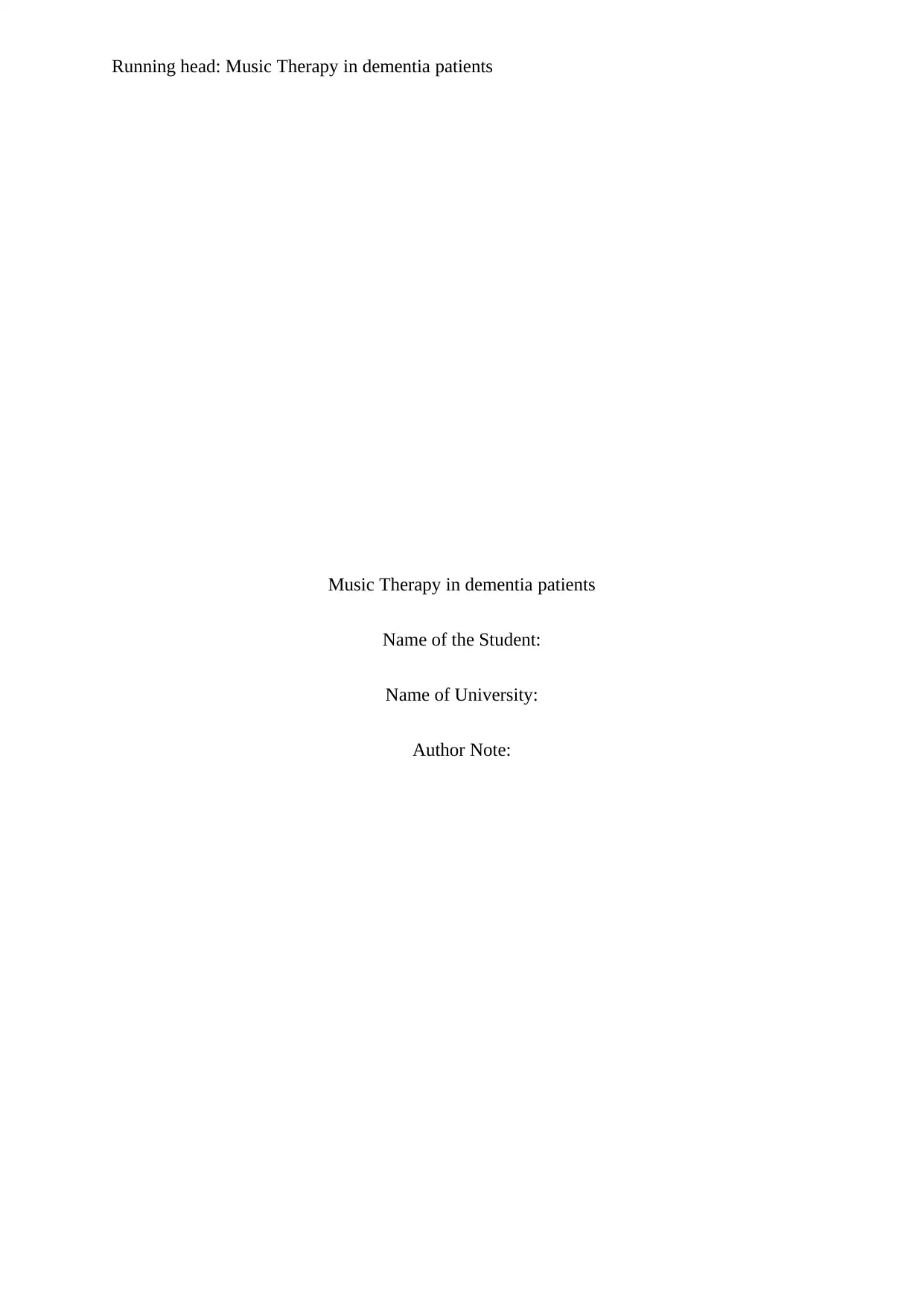
Running head: Music Therapy in dementia patients
Music Therapy in dementia patients
Name of the Student:
Name of University:
Author Note:
Music Therapy in dementia patients
Name of the Student:
Name of University:
Author Note:
Paraphrase This Document
Need a fresh take? Get an instant paraphrase of this document with our AI Paraphraser
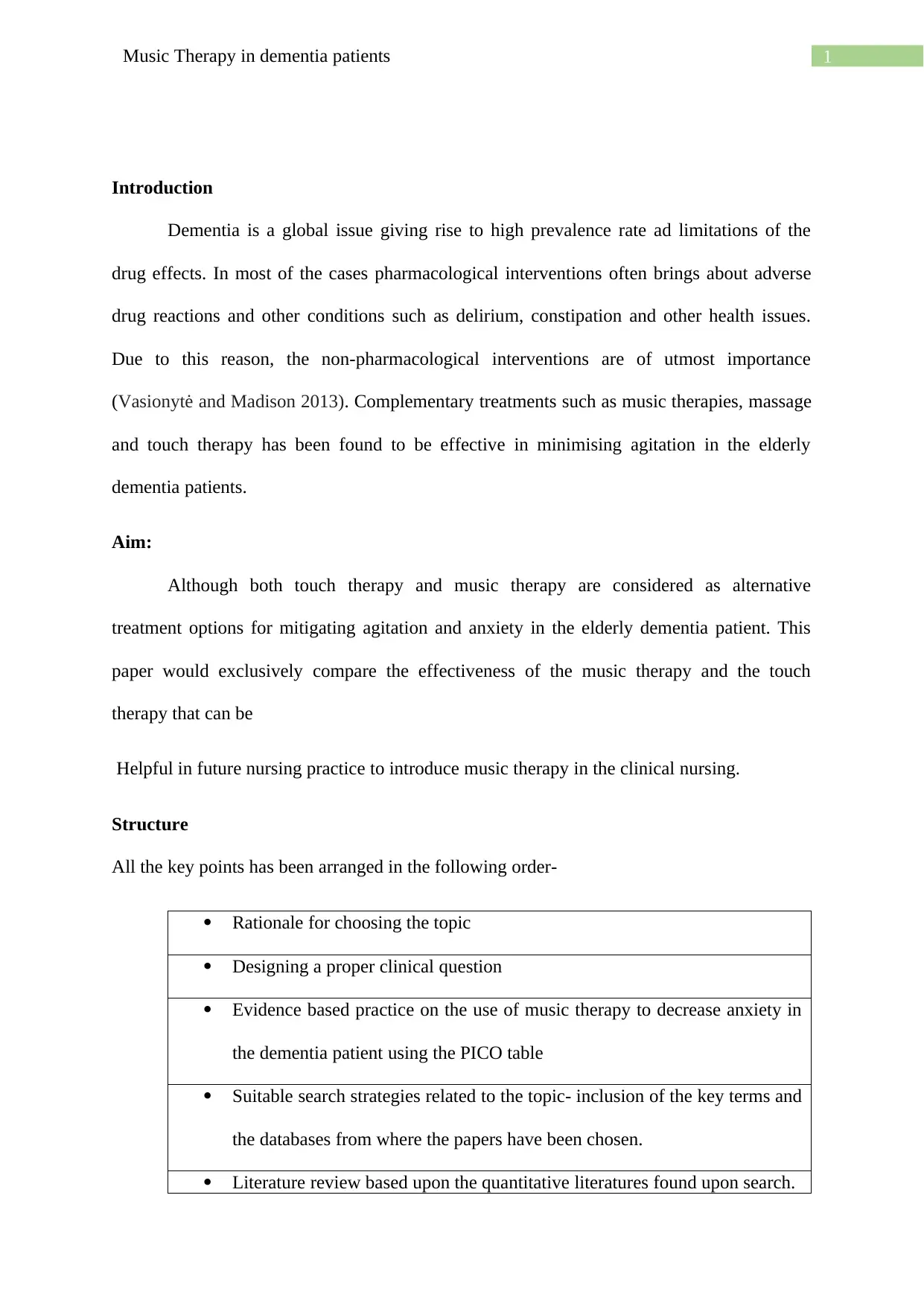
1Music Therapy in dementia patients
Introduction
Dementia is a global issue giving rise to high prevalence rate ad limitations of the
drug effects. In most of the cases pharmacological interventions often brings about adverse
drug reactions and other conditions such as delirium, constipation and other health issues.
Due to this reason, the non-pharmacological interventions are of utmost importance
(Vasionytė and Madison 2013). Complementary treatments such as music therapies, massage
and touch therapy has been found to be effective in minimising agitation in the elderly
dementia patients.
Aim:
Although both touch therapy and music therapy are considered as alternative
treatment options for mitigating agitation and anxiety in the elderly dementia patient. This
paper would exclusively compare the effectiveness of the music therapy and the touch
therapy that can be
Helpful in future nursing practice to introduce music therapy in the clinical nursing.
Structure
All the key points has been arranged in the following order-
Rationale for choosing the topic
Designing a proper clinical question
Evidence based practice on the use of music therapy to decrease anxiety in
the dementia patient using the PICO table
Suitable search strategies related to the topic- inclusion of the key terms and
the databases from where the papers have been chosen.
Literature review based upon the quantitative literatures found upon search.
Introduction
Dementia is a global issue giving rise to high prevalence rate ad limitations of the
drug effects. In most of the cases pharmacological interventions often brings about adverse
drug reactions and other conditions such as delirium, constipation and other health issues.
Due to this reason, the non-pharmacological interventions are of utmost importance
(Vasionytė and Madison 2013). Complementary treatments such as music therapies, massage
and touch therapy has been found to be effective in minimising agitation in the elderly
dementia patients.
Aim:
Although both touch therapy and music therapy are considered as alternative
treatment options for mitigating agitation and anxiety in the elderly dementia patient. This
paper would exclusively compare the effectiveness of the music therapy and the touch
therapy that can be
Helpful in future nursing practice to introduce music therapy in the clinical nursing.
Structure
All the key points has been arranged in the following order-
Rationale for choosing the topic
Designing a proper clinical question
Evidence based practice on the use of music therapy to decrease anxiety in
the dementia patient using the PICO table
Suitable search strategies related to the topic- inclusion of the key terms and
the databases from where the papers have been chosen.
Literature review based upon the quantitative literatures found upon search.
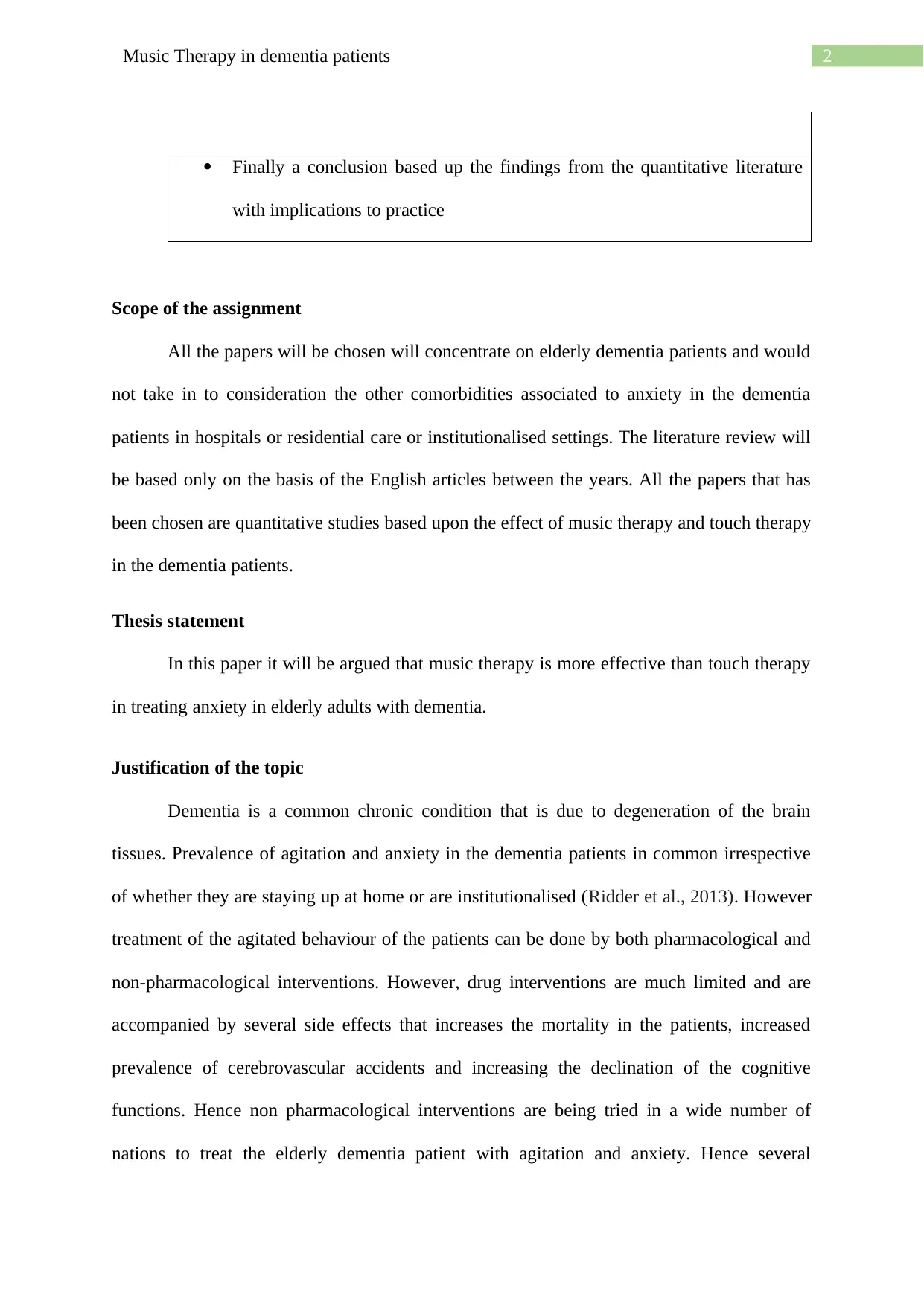
2Music Therapy in dementia patients
Finally a conclusion based up the findings from the quantitative literature
with implications to practice
Scope of the assignment
All the papers will be chosen will concentrate on elderly dementia patients and would
not take in to consideration the other comorbidities associated to anxiety in the dementia
patients in hospitals or residential care or institutionalised settings. The literature review will
be based only on the basis of the English articles between the years. All the papers that has
been chosen are quantitative studies based upon the effect of music therapy and touch therapy
in the dementia patients.
Thesis statement
In this paper it will be argued that music therapy is more effective than touch therapy
in treating anxiety in elderly adults with dementia.
Justification of the topic
Dementia is a common chronic condition that is due to degeneration of the brain
tissues. Prevalence of agitation and anxiety in the dementia patients in common irrespective
of whether they are staying up at home or are institutionalised (Ridder et al., 2013). However
treatment of the agitated behaviour of the patients can be done by both pharmacological and
non-pharmacological interventions. However, drug interventions are much limited and are
accompanied by several side effects that increases the mortality in the patients, increased
prevalence of cerebrovascular accidents and increasing the declination of the cognitive
functions. Hence non pharmacological interventions are being tried in a wide number of
nations to treat the elderly dementia patient with agitation and anxiety. Hence several
Finally a conclusion based up the findings from the quantitative literature
with implications to practice
Scope of the assignment
All the papers will be chosen will concentrate on elderly dementia patients and would
not take in to consideration the other comorbidities associated to anxiety in the dementia
patients in hospitals or residential care or institutionalised settings. The literature review will
be based only on the basis of the English articles between the years. All the papers that has
been chosen are quantitative studies based upon the effect of music therapy and touch therapy
in the dementia patients.
Thesis statement
In this paper it will be argued that music therapy is more effective than touch therapy
in treating anxiety in elderly adults with dementia.
Justification of the topic
Dementia is a common chronic condition that is due to degeneration of the brain
tissues. Prevalence of agitation and anxiety in the dementia patients in common irrespective
of whether they are staying up at home or are institutionalised (Ridder et al., 2013). However
treatment of the agitated behaviour of the patients can be done by both pharmacological and
non-pharmacological interventions. However, drug interventions are much limited and are
accompanied by several side effects that increases the mortality in the patients, increased
prevalence of cerebrovascular accidents and increasing the declination of the cognitive
functions. Hence non pharmacological interventions are being tried in a wide number of
nations to treat the elderly dementia patient with agitation and anxiety. Hence several
⊘ This is a preview!⊘
Do you want full access?
Subscribe today to unlock all pages.

Trusted by 1+ million students worldwide
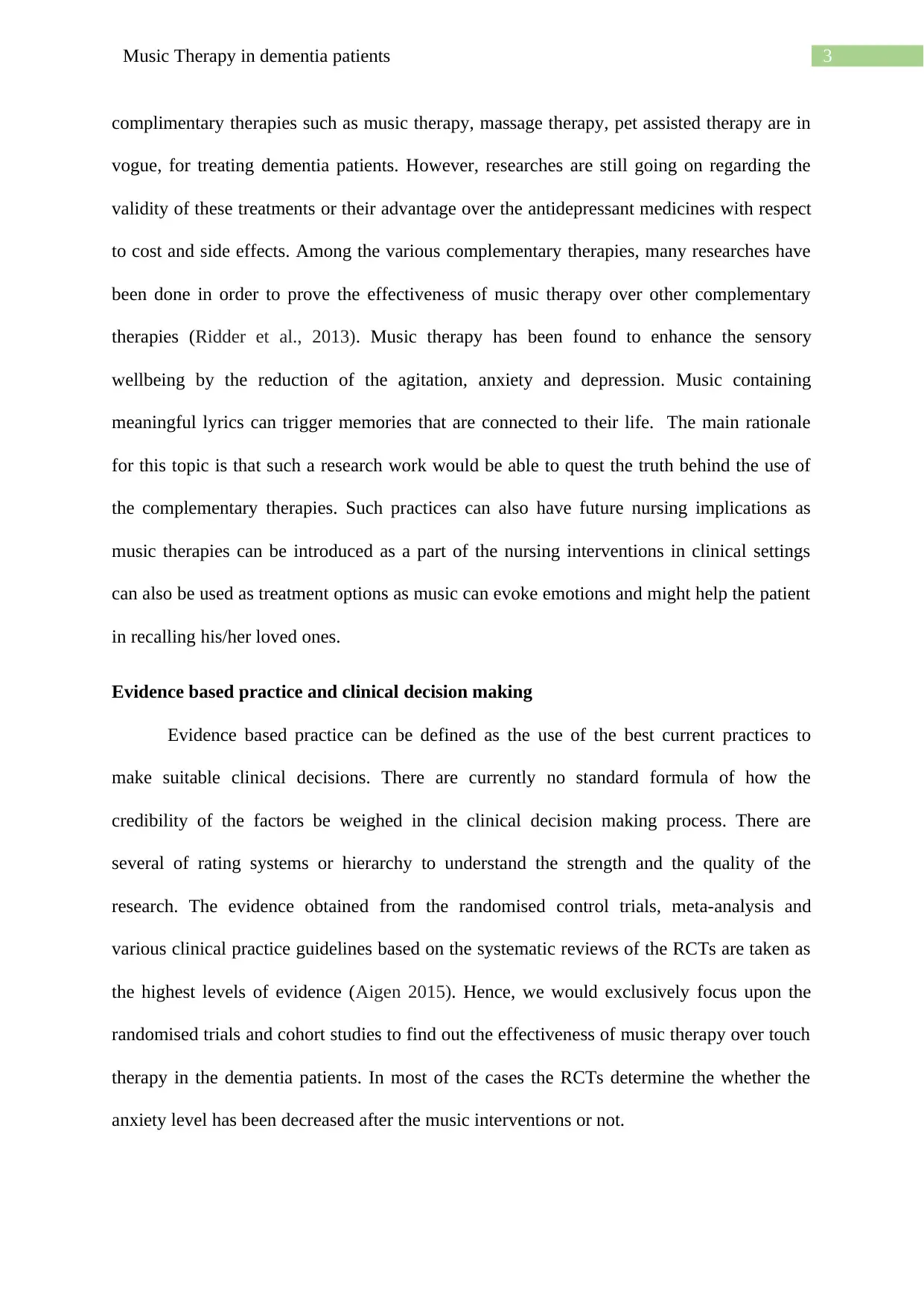
3Music Therapy in dementia patients
complimentary therapies such as music therapy, massage therapy, pet assisted therapy are in
vogue, for treating dementia patients. However, researches are still going on regarding the
validity of these treatments or their advantage over the antidepressant medicines with respect
to cost and side effects. Among the various complementary therapies, many researches have
been done in order to prove the effectiveness of music therapy over other complementary
therapies (Ridder et al., 2013). Music therapy has been found to enhance the sensory
wellbeing by the reduction of the agitation, anxiety and depression. Music containing
meaningful lyrics can trigger memories that are connected to their life. The main rationale
for this topic is that such a research work would be able to quest the truth behind the use of
the complementary therapies. Such practices can also have future nursing implications as
music therapies can be introduced as a part of the nursing interventions in clinical settings
can also be used as treatment options as music can evoke emotions and might help the patient
in recalling his/her loved ones.
Evidence based practice and clinical decision making
Evidence based practice can be defined as the use of the best current practices to
make suitable clinical decisions. There are currently no standard formula of how the
credibility of the factors be weighed in the clinical decision making process. There are
several of rating systems or hierarchy to understand the strength and the quality of the
research. The evidence obtained from the randomised control trials, meta-analysis and
various clinical practice guidelines based on the systematic reviews of the RCTs are taken as
the highest levels of evidence (Aigen 2015). Hence, we would exclusively focus upon the
randomised trials and cohort studies to find out the effectiveness of music therapy over touch
therapy in the dementia patients. In most of the cases the RCTs determine the whether the
anxiety level has been decreased after the music interventions or not.
complimentary therapies such as music therapy, massage therapy, pet assisted therapy are in
vogue, for treating dementia patients. However, researches are still going on regarding the
validity of these treatments or their advantage over the antidepressant medicines with respect
to cost and side effects. Among the various complementary therapies, many researches have
been done in order to prove the effectiveness of music therapy over other complementary
therapies (Ridder et al., 2013). Music therapy has been found to enhance the sensory
wellbeing by the reduction of the agitation, anxiety and depression. Music containing
meaningful lyrics can trigger memories that are connected to their life. The main rationale
for this topic is that such a research work would be able to quest the truth behind the use of
the complementary therapies. Such practices can also have future nursing implications as
music therapies can be introduced as a part of the nursing interventions in clinical settings
can also be used as treatment options as music can evoke emotions and might help the patient
in recalling his/her loved ones.
Evidence based practice and clinical decision making
Evidence based practice can be defined as the use of the best current practices to
make suitable clinical decisions. There are currently no standard formula of how the
credibility of the factors be weighed in the clinical decision making process. There are
several of rating systems or hierarchy to understand the strength and the quality of the
research. The evidence obtained from the randomised control trials, meta-analysis and
various clinical practice guidelines based on the systematic reviews of the RCTs are taken as
the highest levels of evidence (Aigen 2015). Hence, we would exclusively focus upon the
randomised trials and cohort studies to find out the effectiveness of music therapy over touch
therapy in the dementia patients. In most of the cases the RCTs determine the whether the
anxiety level has been decreased after the music interventions or not.
Paraphrase This Document
Need a fresh take? Get an instant paraphrase of this document with our AI Paraphraser
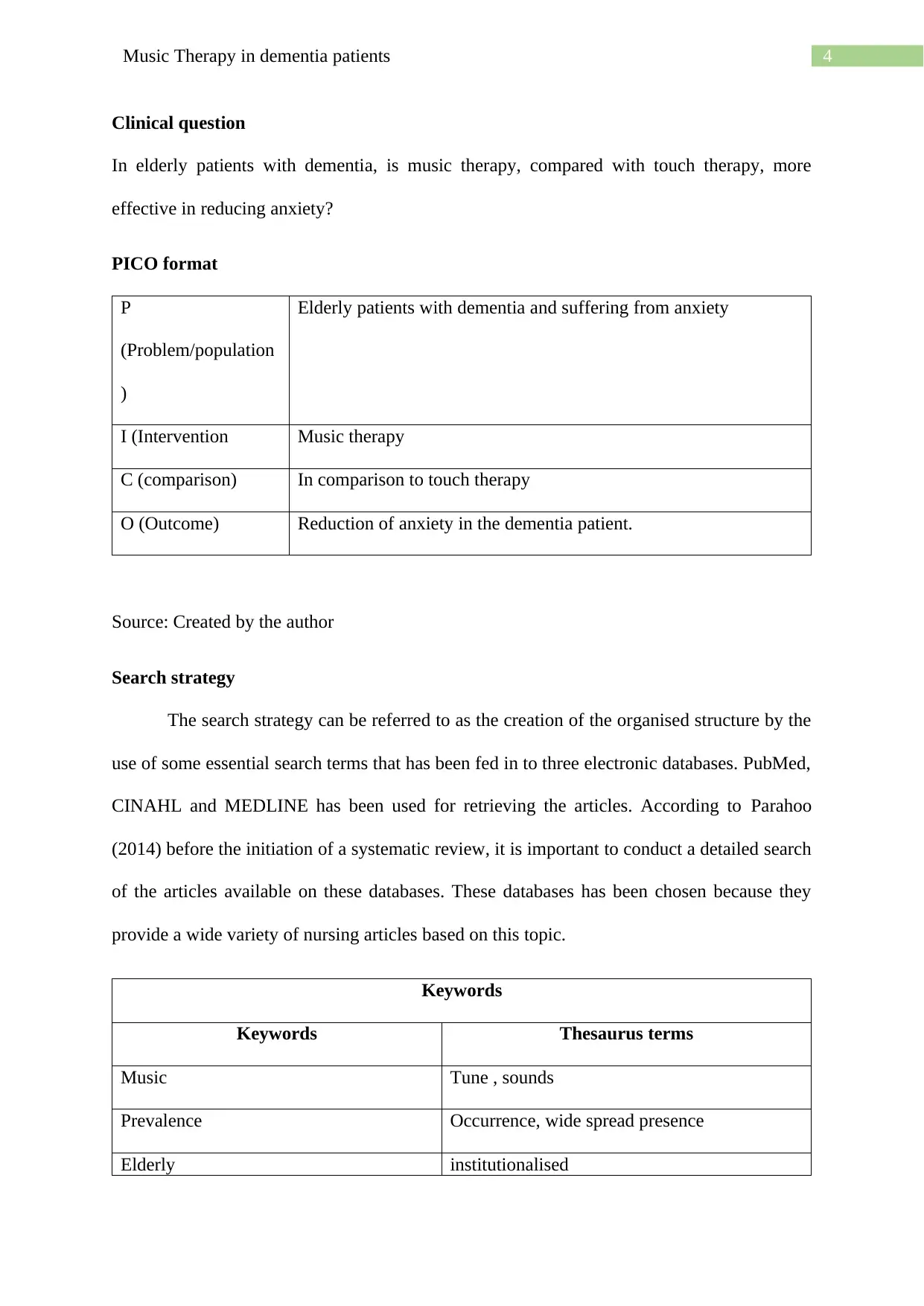
4Music Therapy in dementia patients
Clinical question
In elderly patients with dementia, is music therapy, compared with touch therapy, more
effective in reducing anxiety?
PICO format
P
(Problem/population
)
Elderly patients with dementia and suffering from anxiety
I (Intervention Music therapy
C (comparison) In comparison to touch therapy
O (Outcome) Reduction of anxiety in the dementia patient.
Source: Created by the author
Search strategy
The search strategy can be referred to as the creation of the organised structure by the
use of some essential search terms that has been fed in to three electronic databases. PubMed,
CINAHL and MEDLINE has been used for retrieving the articles. According to Parahoo
(2014) before the initiation of a systematic review, it is important to conduct a detailed search
of the articles available on these databases. These databases has been chosen because they
provide a wide variety of nursing articles based on this topic.
Keywords
Keywords Thesaurus terms
Music Tune , sounds
Prevalence Occurrence, wide spread presence
Elderly institutionalised
Clinical question
In elderly patients with dementia, is music therapy, compared with touch therapy, more
effective in reducing anxiety?
PICO format
P
(Problem/population
)
Elderly patients with dementia and suffering from anxiety
I (Intervention Music therapy
C (comparison) In comparison to touch therapy
O (Outcome) Reduction of anxiety in the dementia patient.
Source: Created by the author
Search strategy
The search strategy can be referred to as the creation of the organised structure by the
use of some essential search terms that has been fed in to three electronic databases. PubMed,
CINAHL and MEDLINE has been used for retrieving the articles. According to Parahoo
(2014) before the initiation of a systematic review, it is important to conduct a detailed search
of the articles available on these databases. These databases has been chosen because they
provide a wide variety of nursing articles based on this topic.
Keywords
Keywords Thesaurus terms
Music Tune , sounds
Prevalence Occurrence, wide spread presence
Elderly institutionalised
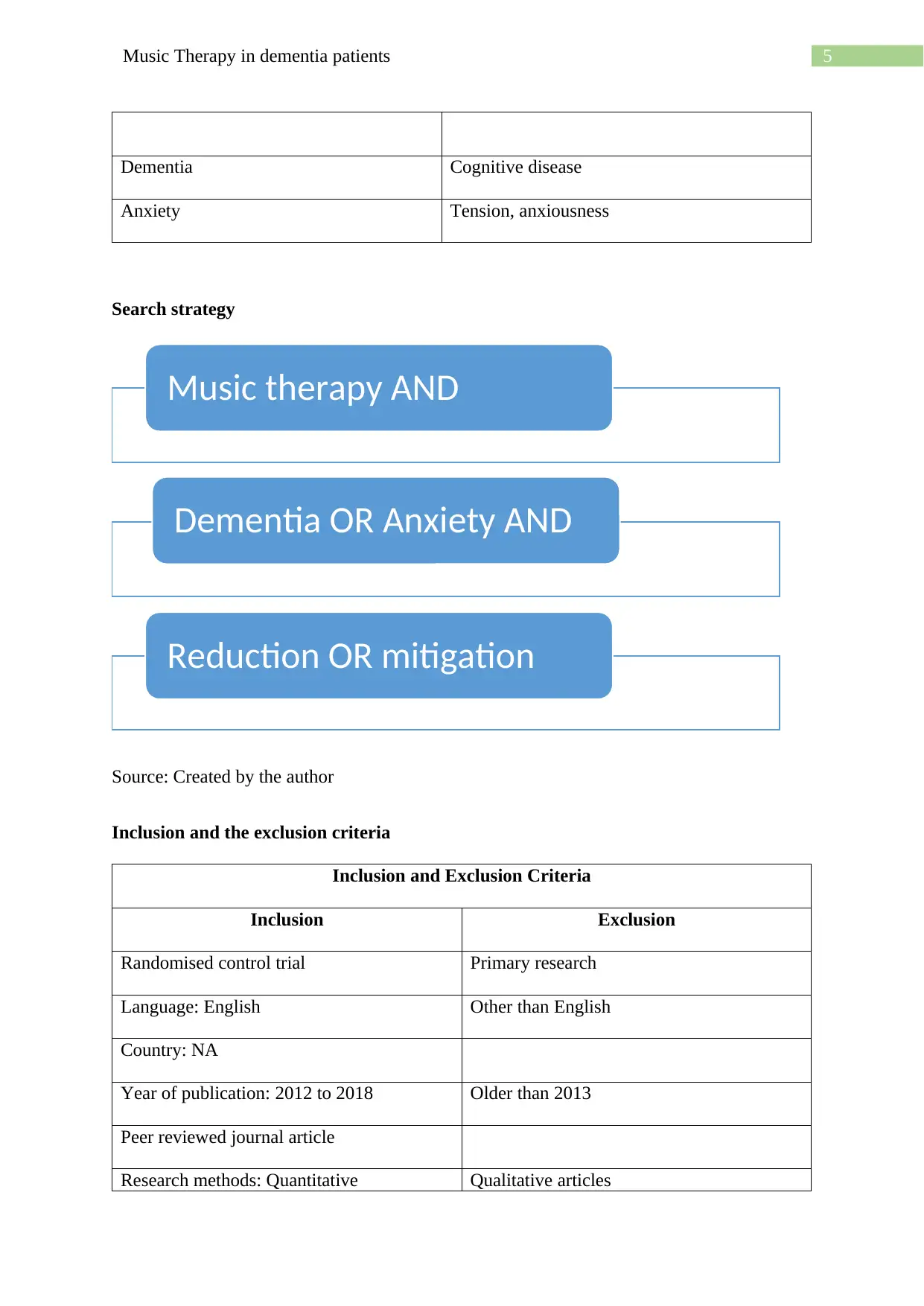
5Music Therapy in dementia patients
Dementia Cognitive disease
Anxiety Tension, anxiousness
Search strategy
Source: Created by the author
Inclusion and the exclusion criteria
Inclusion and Exclusion Criteria
Inclusion Exclusion
Randomised control trial Primary research
Language: English Other than English
Country: NA
Year of publication: 2012 to 2018 Older than 2013
Peer reviewed journal article
Research methods: Quantitative Qualitative articles
Music therapy AND
Dementia OR Anxiety AND
Reduction OR mitigation
Dementia Cognitive disease
Anxiety Tension, anxiousness
Search strategy
Source: Created by the author
Inclusion and the exclusion criteria
Inclusion and Exclusion Criteria
Inclusion Exclusion
Randomised control trial Primary research
Language: English Other than English
Country: NA
Year of publication: 2012 to 2018 Older than 2013
Peer reviewed journal article
Research methods: Quantitative Qualitative articles
Music therapy AND
Dementia OR Anxiety AND
Reduction OR mitigation
⊘ This is a preview!⊘
Do you want full access?
Subscribe today to unlock all pages.

Trusted by 1+ million students worldwide
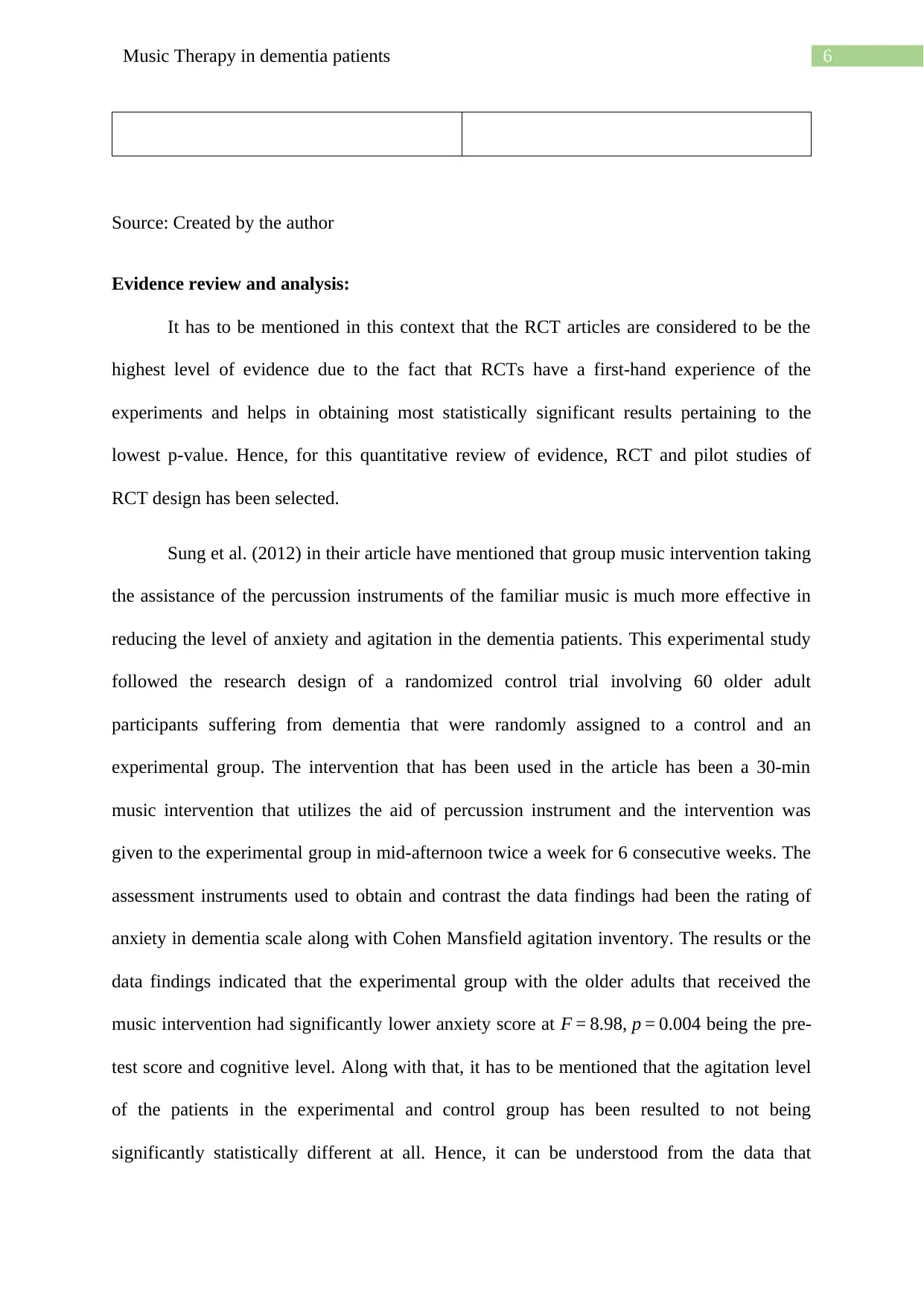
6Music Therapy in dementia patients
Source: Created by the author
Evidence review and analysis:
It has to be mentioned in this context that the RCT articles are considered to be the
highest level of evidence due to the fact that RCTs have a first-hand experience of the
experiments and helps in obtaining most statistically significant results pertaining to the
lowest p-value. Hence, for this quantitative review of evidence, RCT and pilot studies of
RCT design has been selected.
Sung et al. (2012) in their article have mentioned that group music intervention taking
the assistance of the percussion instruments of the familiar music is much more effective in
reducing the level of anxiety and agitation in the dementia patients. This experimental study
followed the research design of a randomized control trial involving 60 older adult
participants suffering from dementia that were randomly assigned to a control and an
experimental group. The intervention that has been used in the article has been a 30-min
music intervention that utilizes the aid of percussion instrument and the intervention was
given to the experimental group in mid-afternoon twice a week for 6 consecutive weeks. The
assessment instruments used to obtain and contrast the data findings had been the rating of
anxiety in dementia scale along with Cohen Mansfield agitation inventory. The results or the
data findings indicated that the experimental group with the older adults that received the
music intervention had significantly lower anxiety score at F = 8.98, p = 0.004 being the pre-
test score and cognitive level. Along with that, it has to be mentioned that the agitation level
of the patients in the experimental and control group has been resulted to not being
significantly statistically different at all. Hence, it can be understood from the data that
Source: Created by the author
Evidence review and analysis:
It has to be mentioned in this context that the RCT articles are considered to be the
highest level of evidence due to the fact that RCTs have a first-hand experience of the
experiments and helps in obtaining most statistically significant results pertaining to the
lowest p-value. Hence, for this quantitative review of evidence, RCT and pilot studies of
RCT design has been selected.
Sung et al. (2012) in their article have mentioned that group music intervention taking
the assistance of the percussion instruments of the familiar music is much more effective in
reducing the level of anxiety and agitation in the dementia patients. This experimental study
followed the research design of a randomized control trial involving 60 older adult
participants suffering from dementia that were randomly assigned to a control and an
experimental group. The intervention that has been used in the article has been a 30-min
music intervention that utilizes the aid of percussion instrument and the intervention was
given to the experimental group in mid-afternoon twice a week for 6 consecutive weeks. The
assessment instruments used to obtain and contrast the data findings had been the rating of
anxiety in dementia scale along with Cohen Mansfield agitation inventory. The results or the
data findings indicated that the experimental group with the older adults that received the
music intervention had significantly lower anxiety score at F = 8.98, p = 0.004 being the pre-
test score and cognitive level. Along with that, it has to be mentioned that the agitation level
of the patients in the experimental and control group has been resulted to not being
significantly statistically different at all. Hence, it can be understood from the data that
Paraphrase This Document
Need a fresh take? Get an instant paraphrase of this document with our AI Paraphraser
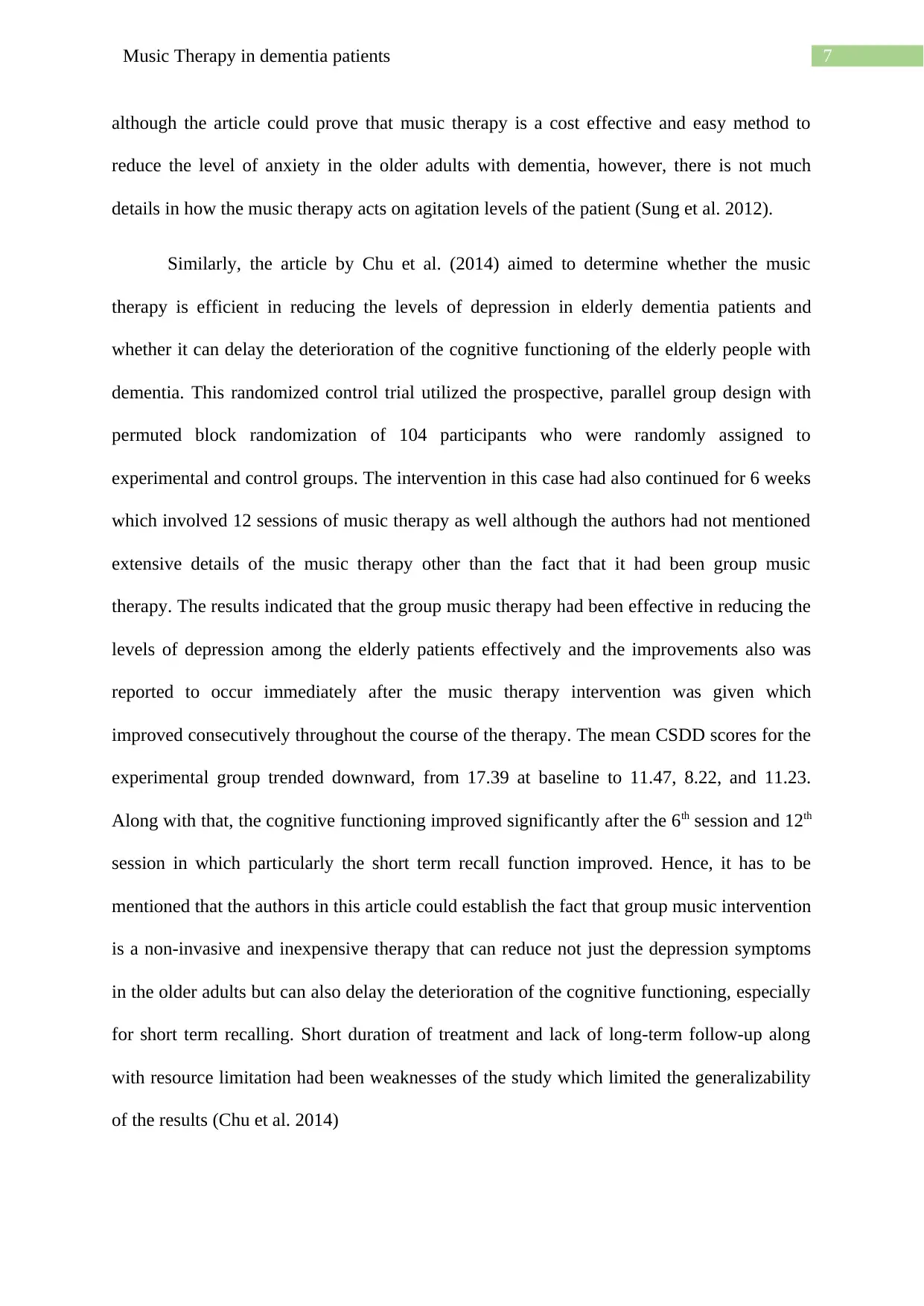
7Music Therapy in dementia patients
although the article could prove that music therapy is a cost effective and easy method to
reduce the level of anxiety in the older adults with dementia, however, there is not much
details in how the music therapy acts on agitation levels of the patient (Sung et al. 2012).
Similarly, the article by Chu et al. (2014) aimed to determine whether the music
therapy is efficient in reducing the levels of depression in elderly dementia patients and
whether it can delay the deterioration of the cognitive functioning of the elderly people with
dementia. This randomized control trial utilized the prospective, parallel group design with
permuted block randomization of 104 participants who were randomly assigned to
experimental and control groups. The intervention in this case had also continued for 6 weeks
which involved 12 sessions of music therapy as well although the authors had not mentioned
extensive details of the music therapy other than the fact that it had been group music
therapy. The results indicated that the group music therapy had been effective in reducing the
levels of depression among the elderly patients effectively and the improvements also was
reported to occur immediately after the music therapy intervention was given which
improved consecutively throughout the course of the therapy. The mean CSDD scores for the
experimental group trended downward, from 17.39 at baseline to 11.47, 8.22, and 11.23.
Along with that, the cognitive functioning improved significantly after the 6th session and 12th
session in which particularly the short term recall function improved. Hence, it has to be
mentioned that the authors in this article could establish the fact that group music intervention
is a non-invasive and inexpensive therapy that can reduce not just the depression symptoms
in the older adults but can also delay the deterioration of the cognitive functioning, especially
for short term recalling. Short duration of treatment and lack of long-term follow-up along
with resource limitation had been weaknesses of the study which limited the generalizability
of the results (Chu et al. 2014)
although the article could prove that music therapy is a cost effective and easy method to
reduce the level of anxiety in the older adults with dementia, however, there is not much
details in how the music therapy acts on agitation levels of the patient (Sung et al. 2012).
Similarly, the article by Chu et al. (2014) aimed to determine whether the music
therapy is efficient in reducing the levels of depression in elderly dementia patients and
whether it can delay the deterioration of the cognitive functioning of the elderly people with
dementia. This randomized control trial utilized the prospective, parallel group design with
permuted block randomization of 104 participants who were randomly assigned to
experimental and control groups. The intervention in this case had also continued for 6 weeks
which involved 12 sessions of music therapy as well although the authors had not mentioned
extensive details of the music therapy other than the fact that it had been group music
therapy. The results indicated that the group music therapy had been effective in reducing the
levels of depression among the elderly patients effectively and the improvements also was
reported to occur immediately after the music therapy intervention was given which
improved consecutively throughout the course of the therapy. The mean CSDD scores for the
experimental group trended downward, from 17.39 at baseline to 11.47, 8.22, and 11.23.
Along with that, the cognitive functioning improved significantly after the 6th session and 12th
session in which particularly the short term recall function improved. Hence, it has to be
mentioned that the authors in this article could establish the fact that group music intervention
is a non-invasive and inexpensive therapy that can reduce not just the depression symptoms
in the older adults but can also delay the deterioration of the cognitive functioning, especially
for short term recalling. Short duration of treatment and lack of long-term follow-up along
with resource limitation had been weaknesses of the study which limited the generalizability
of the results (Chu et al. 2014)
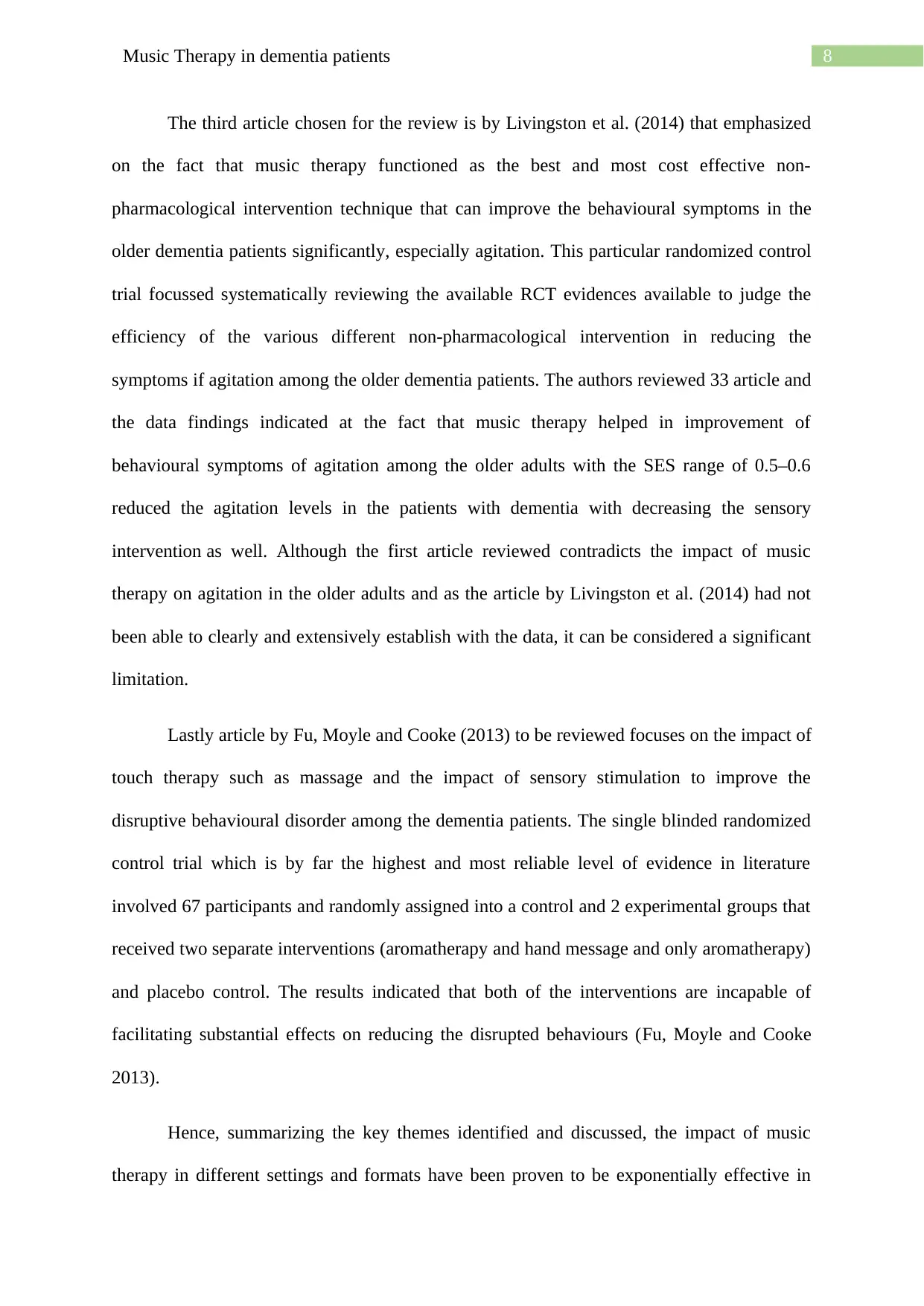
8Music Therapy in dementia patients
The third article chosen for the review is by Livingston et al. (2014) that emphasized
on the fact that music therapy functioned as the best and most cost effective non-
pharmacological intervention technique that can improve the behavioural symptoms in the
older dementia patients significantly, especially agitation. This particular randomized control
trial focussed systematically reviewing the available RCT evidences available to judge the
efficiency of the various different non-pharmacological intervention in reducing the
symptoms if agitation among the older dementia patients. The authors reviewed 33 article and
the data findings indicated at the fact that music therapy helped in improvement of
behavioural symptoms of agitation among the older adults with the SES range of 0.5–0.6
reduced the agitation levels in the patients with dementia with decreasing the sensory
intervention as well. Although the first article reviewed contradicts the impact of music
therapy on agitation in the older adults and as the article by Livingston et al. (2014) had not
been able to clearly and extensively establish with the data, it can be considered a significant
limitation.
Lastly article by Fu, Moyle and Cooke (2013) to be reviewed focuses on the impact of
touch therapy such as massage and the impact of sensory stimulation to improve the
disruptive behavioural disorder among the dementia patients. The single blinded randomized
control trial which is by far the highest and most reliable level of evidence in literature
involved 67 participants and randomly assigned into a control and 2 experimental groups that
received two separate interventions (aromatherapy and hand message and only aromatherapy)
and placebo control. The results indicated that both of the interventions are incapable of
facilitating substantial effects on reducing the disrupted behaviours (Fu, Moyle and Cooke
2013).
Hence, summarizing the key themes identified and discussed, the impact of music
therapy in different settings and formats have been proven to be exponentially effective in
The third article chosen for the review is by Livingston et al. (2014) that emphasized
on the fact that music therapy functioned as the best and most cost effective non-
pharmacological intervention technique that can improve the behavioural symptoms in the
older dementia patients significantly, especially agitation. This particular randomized control
trial focussed systematically reviewing the available RCT evidences available to judge the
efficiency of the various different non-pharmacological intervention in reducing the
symptoms if agitation among the older dementia patients. The authors reviewed 33 article and
the data findings indicated at the fact that music therapy helped in improvement of
behavioural symptoms of agitation among the older adults with the SES range of 0.5–0.6
reduced the agitation levels in the patients with dementia with decreasing the sensory
intervention as well. Although the first article reviewed contradicts the impact of music
therapy on agitation in the older adults and as the article by Livingston et al. (2014) had not
been able to clearly and extensively establish with the data, it can be considered a significant
limitation.
Lastly article by Fu, Moyle and Cooke (2013) to be reviewed focuses on the impact of
touch therapy such as massage and the impact of sensory stimulation to improve the
disruptive behavioural disorder among the dementia patients. The single blinded randomized
control trial which is by far the highest and most reliable level of evidence in literature
involved 67 participants and randomly assigned into a control and 2 experimental groups that
received two separate interventions (aromatherapy and hand message and only aromatherapy)
and placebo control. The results indicated that both of the interventions are incapable of
facilitating substantial effects on reducing the disrupted behaviours (Fu, Moyle and Cooke
2013).
Hence, summarizing the key themes identified and discussed, the impact of music
therapy in different settings and formats have been proven to be exponentially effective in
⊘ This is a preview!⊘
Do you want full access?
Subscribe today to unlock all pages.

Trusted by 1+ million students worldwide
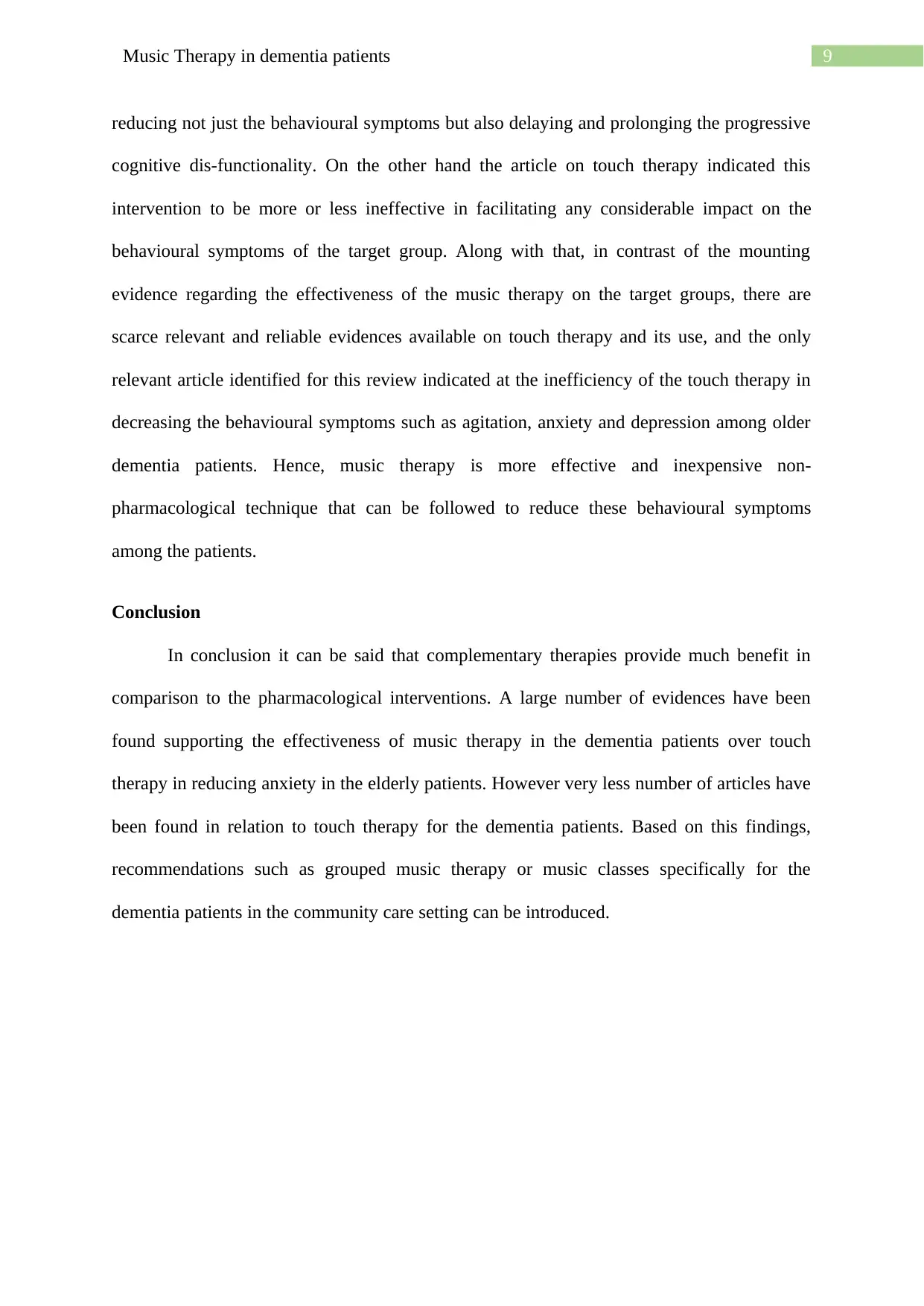
9Music Therapy in dementia patients
reducing not just the behavioural symptoms but also delaying and prolonging the progressive
cognitive dis-functionality. On the other hand the article on touch therapy indicated this
intervention to be more or less ineffective in facilitating any considerable impact on the
behavioural symptoms of the target group. Along with that, in contrast of the mounting
evidence regarding the effectiveness of the music therapy on the target groups, there are
scarce relevant and reliable evidences available on touch therapy and its use, and the only
relevant article identified for this review indicated at the inefficiency of the touch therapy in
decreasing the behavioural symptoms such as agitation, anxiety and depression among older
dementia patients. Hence, music therapy is more effective and inexpensive non-
pharmacological technique that can be followed to reduce these behavioural symptoms
among the patients.
Conclusion
In conclusion it can be said that complementary therapies provide much benefit in
comparison to the pharmacological interventions. A large number of evidences have been
found supporting the effectiveness of music therapy in the dementia patients over touch
therapy in reducing anxiety in the elderly patients. However very less number of articles have
been found in relation to touch therapy for the dementia patients. Based on this findings,
recommendations such as grouped music therapy or music classes specifically for the
dementia patients in the community care setting can be introduced.
reducing not just the behavioural symptoms but also delaying and prolonging the progressive
cognitive dis-functionality. On the other hand the article on touch therapy indicated this
intervention to be more or less ineffective in facilitating any considerable impact on the
behavioural symptoms of the target group. Along with that, in contrast of the mounting
evidence regarding the effectiveness of the music therapy on the target groups, there are
scarce relevant and reliable evidences available on touch therapy and its use, and the only
relevant article identified for this review indicated at the inefficiency of the touch therapy in
decreasing the behavioural symptoms such as agitation, anxiety and depression among older
dementia patients. Hence, music therapy is more effective and inexpensive non-
pharmacological technique that can be followed to reduce these behavioural symptoms
among the patients.
Conclusion
In conclusion it can be said that complementary therapies provide much benefit in
comparison to the pharmacological interventions. A large number of evidences have been
found supporting the effectiveness of music therapy in the dementia patients over touch
therapy in reducing anxiety in the elderly patients. However very less number of articles have
been found in relation to touch therapy for the dementia patients. Based on this findings,
recommendations such as grouped music therapy or music classes specifically for the
dementia patients in the community care setting can be introduced.
Paraphrase This Document
Need a fresh take? Get an instant paraphrase of this document with our AI Paraphraser
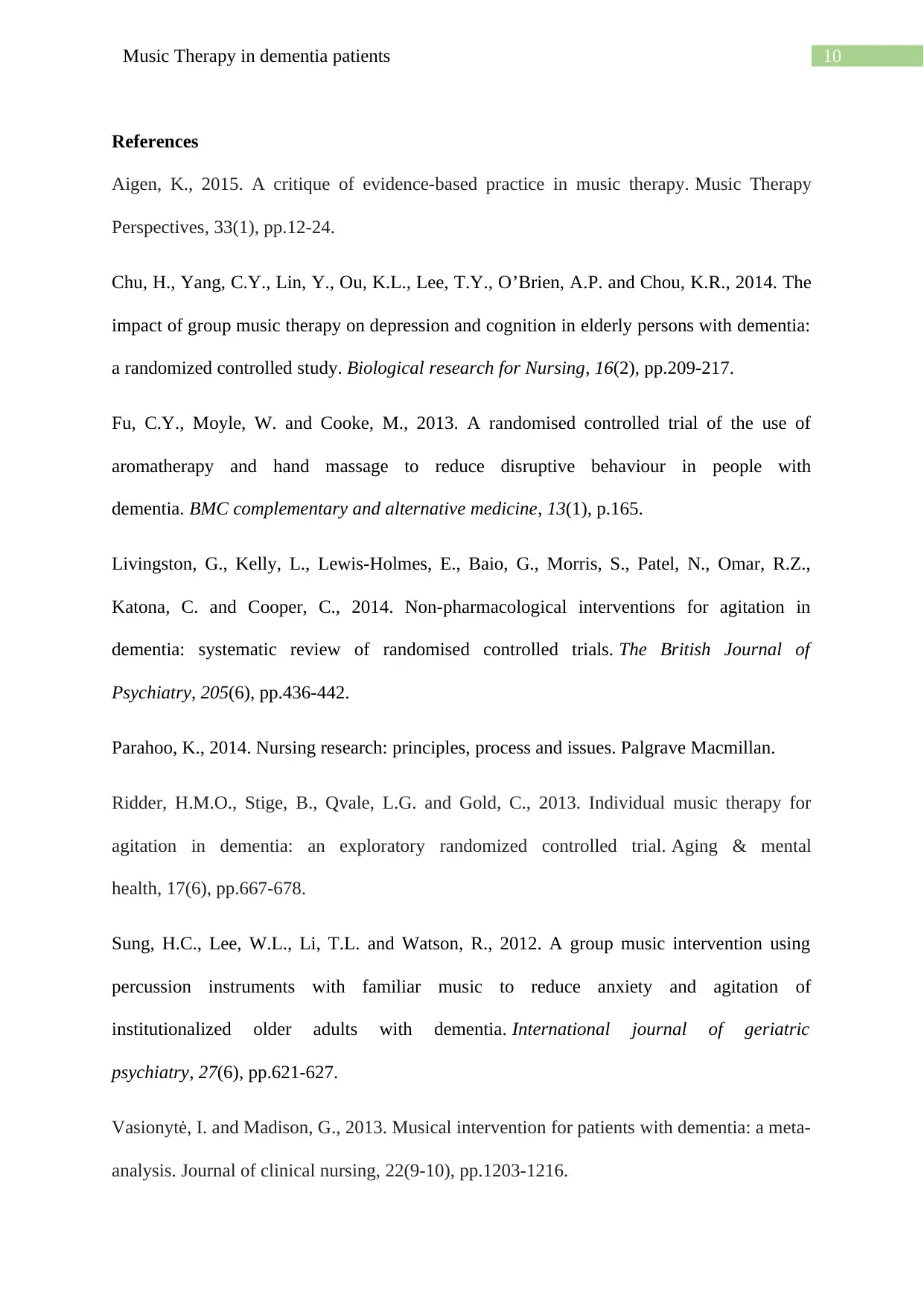
10Music Therapy in dementia patients
References
Aigen, K., 2015. A critique of evidence-based practice in music therapy. Music Therapy
Perspectives, 33(1), pp.12-24.
Chu, H., Yang, C.Y., Lin, Y., Ou, K.L., Lee, T.Y., O’Brien, A.P. and Chou, K.R., 2014. The
impact of group music therapy on depression and cognition in elderly persons with dementia:
a randomized controlled study. Biological research for Nursing, 16(2), pp.209-217.
Fu, C.Y., Moyle, W. and Cooke, M., 2013. A randomised controlled trial of the use of
aromatherapy and hand massage to reduce disruptive behaviour in people with
dementia. BMC complementary and alternative medicine, 13(1), p.165.
Livingston, G., Kelly, L., Lewis-Holmes, E., Baio, G., Morris, S., Patel, N., Omar, R.Z.,
Katona, C. and Cooper, C., 2014. Non-pharmacological interventions for agitation in
dementia: systematic review of randomised controlled trials. The British Journal of
Psychiatry, 205(6), pp.436-442.
Parahoo, K., 2014. Nursing research: principles, process and issues. Palgrave Macmillan.
Ridder, H.M.O., Stige, B., Qvale, L.G. and Gold, C., 2013. Individual music therapy for
agitation in dementia: an exploratory randomized controlled trial. Aging & mental
health, 17(6), pp.667-678.
Sung, H.C., Lee, W.L., Li, T.L. and Watson, R., 2012. A group music intervention using
percussion instruments with familiar music to reduce anxiety and agitation of
institutionalized older adults with dementia. International journal of geriatric
psychiatry, 27(6), pp.621-627.
Vasionytė, I. and Madison, G., 2013. Musical intervention for patients with dementia: a meta‐
analysis. Journal of clinical nursing, 22(9-10), pp.1203-1216.
References
Aigen, K., 2015. A critique of evidence-based practice in music therapy. Music Therapy
Perspectives, 33(1), pp.12-24.
Chu, H., Yang, C.Y., Lin, Y., Ou, K.L., Lee, T.Y., O’Brien, A.P. and Chou, K.R., 2014. The
impact of group music therapy on depression and cognition in elderly persons with dementia:
a randomized controlled study. Biological research for Nursing, 16(2), pp.209-217.
Fu, C.Y., Moyle, W. and Cooke, M., 2013. A randomised controlled trial of the use of
aromatherapy and hand massage to reduce disruptive behaviour in people with
dementia. BMC complementary and alternative medicine, 13(1), p.165.
Livingston, G., Kelly, L., Lewis-Holmes, E., Baio, G., Morris, S., Patel, N., Omar, R.Z.,
Katona, C. and Cooper, C., 2014. Non-pharmacological interventions for agitation in
dementia: systematic review of randomised controlled trials. The British Journal of
Psychiatry, 205(6), pp.436-442.
Parahoo, K., 2014. Nursing research: principles, process and issues. Palgrave Macmillan.
Ridder, H.M.O., Stige, B., Qvale, L.G. and Gold, C., 2013. Individual music therapy for
agitation in dementia: an exploratory randomized controlled trial. Aging & mental
health, 17(6), pp.667-678.
Sung, H.C., Lee, W.L., Li, T.L. and Watson, R., 2012. A group music intervention using
percussion instruments with familiar music to reduce anxiety and agitation of
institutionalized older adults with dementia. International journal of geriatric
psychiatry, 27(6), pp.621-627.
Vasionytė, I. and Madison, G., 2013. Musical intervention for patients with dementia: a meta‐
analysis. Journal of clinical nursing, 22(9-10), pp.1203-1216.

11Music Therapy in dementia patients
⊘ This is a preview!⊘
Do you want full access?
Subscribe today to unlock all pages.

Trusted by 1+ million students worldwide
1 out of 12
Related Documents
Your All-in-One AI-Powered Toolkit for Academic Success.
+13062052269
info@desklib.com
Available 24*7 on WhatsApp / Email
![[object Object]](/_next/static/media/star-bottom.7253800d.svg)
Unlock your academic potential
Copyright © 2020–2025 A2Z Services. All Rights Reserved. Developed and managed by ZUCOL.




